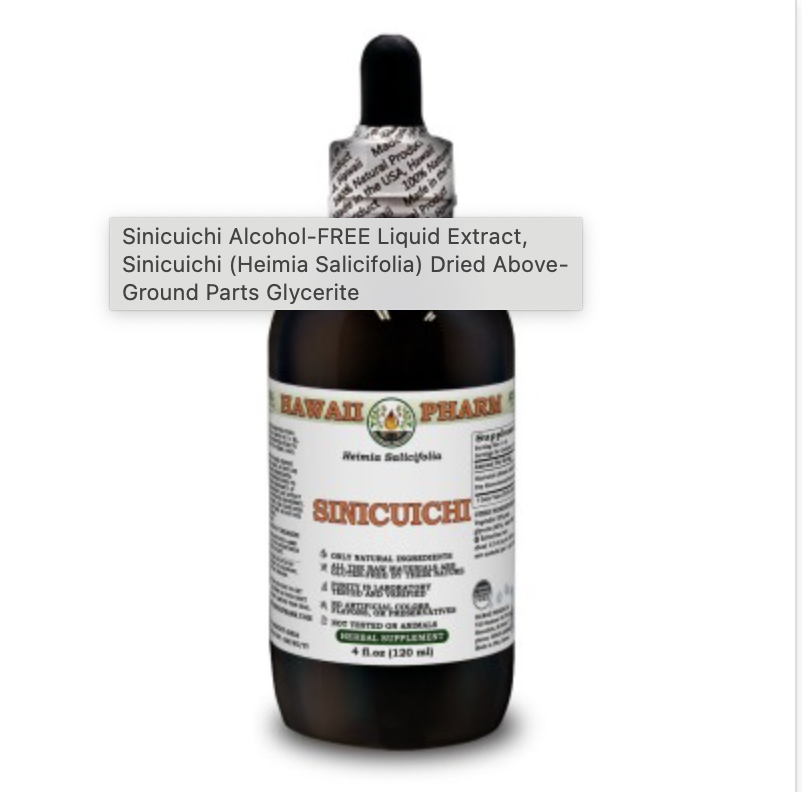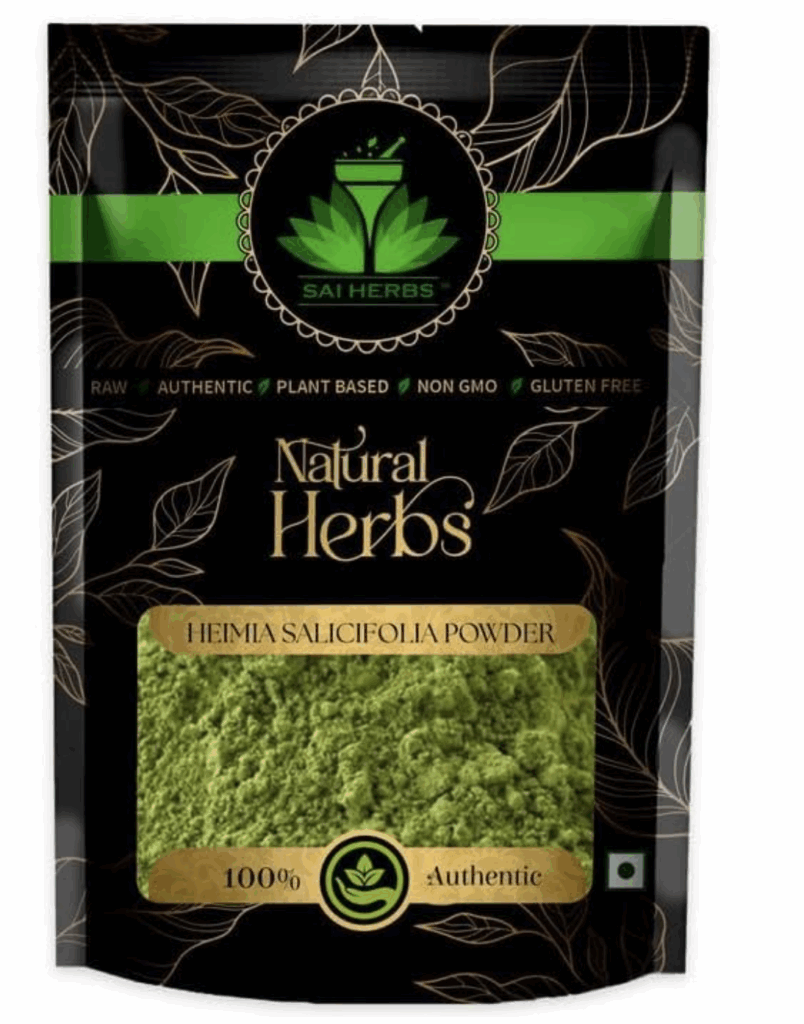Yukutuchi, also spelled Yucutuchi, is an important sacred medicine for the release of physical pain that has an emotional component to it. Also known as Sinicuichi, with an alternative spelling of Sinicuiche, the Latin name is Heimia salicifolia. We will use all of these names as we discuss this plant as some people are familiar with one particular name or spelling.
Yukutuchi produces mild psychoactive effects involving the sense of hearing and vision while it works to disentangle physical pain in the body that has a basis in the stress and trauma response. Some people experience physical cramping and soreness after taking this herb. Others do not.
Heimia salicifolia is a bushy plant in the Lythraceae family with small, dark green leaves that grows to between 4 to 10 feet tall. It has tiny yellow flowers and it tends to be found in ditches and wet soils. Stems emerge in numerous quantities from the base of the plant, glabrous. Leaves are opposite or sub-opposite, sessile, and broadly to narrowly elliptic. It is native to tropical regions in Texas, Mexico, Central, and South America.
Heimia salicifolia seeds must be sprinkled on the surface of soil that is flat and slightly misted with water for planting. Germination of this plant is relatively easy to accomplish actually. It prefers well-draining, slightly acidic soil. Water the seeds daily in spring and summer and give it 4 hours of direct sunlight daily. It prefers heavy to partial shade the rest of the time. Miracle Grow or an organic fertilizer every 10 days may help it grow too. It likes a lot of root space and becomes pot-bound quickly when planted indoors in pots.
Heimia salicifolia is 100% legal in the United States and Mexico. It is legal in all countries of the world at the time of this writing.
Heimia salicifolia Medicinal Effects
Heimia salicifolia is a well-known plant medicine in Mexico where it is often administered in temazcals (a type of sweat lodge). The Aztec shamans once worked with this plant as a trance-inducing divination medicine, but it can also be used to heal physical issues in the body including addiction.
Some people report experiencing muscle cramping and muscle pain for up to a few days after taking Yukutuchi. Not everyone experiences this, but these physical pains might be viewed as physical pain that needs to be released in order for the body in order to heal. If you go into this experience expecting a powerfully psychoactive experience sans physical components, Yukutuchi might be disappointing. On the other hand, if you’re using this medicine to heal your body and your mind of addiction, Heimia salicifolia has an excellent pain-relieving profile that may (or may not) initially cause an enhancement of pain in order to reduce the inflammatory and pain-producing process overall. Many people describe the after-pain of muscle soreness from Yukutuchi as akin to a detoxification reaction.
Yukutuchi is only mildly psychoactive which makes it a good choice for those who are just beginning to work with the sacred medicines.

Click here to subscribe to the Living Database now.
Medicinal Substances Found in Heimia salicifolia / Yucutuchi
Heimia salicifolia produces a number of medicinal effects including:
- Laxative effects
- Diuretic effects
- Syphilis treatment
- Constipation treatment / laxative
- Detoxification
- Varicose veins
- Restless legs syndrome treatment
- Muscle pain treatment
- Tendon-healing
- Bone-healing
- Connective-tissue healing
- Myalgia treatment (treatment for muscle pain)
- Organ-healing
- Arthritis treatment
- Post-partum healing of pelvis, muscle and tissue tears, etc. (administer a full-body decoction topically via a bath)
- Lifts the uterus and bladder (it heals organ prolapse)
- Uterine inflammation treatment
- Uterine fibroid treatment
- Urinary tract disease treatment
- Reduces urinary incontinence
- Prostate-healing
- Kidney disease treatment
- Cleanses the kidneys
- Liver disease treatment
- Cellular regeneration
- Epilepsy treatment
- Hearing issues
- Vision issues
- Inflammation treatment
- Mental health issues
- Post-traumatic stress disorder (PTSD) treatment
- Depression treatment
- Anxiety treatment
- Addiction treatment (works especially for cocaine and stimulant addiction)
- Fever reduction / anti-pyretic
- Sudorific (sweat-inducing) effects
- Emetic
- Antimalarial effects
- Improves blood flow throughout the body and heart
- Vasodilation
- Antihypertensive / Lowers blood pressure
- Muscle toning
- Weight loss promotion
- Improves fertility in both men and women
- Raises potassium levels
- Removes “cold” from the body
- Antiparasitic
- Bruises (ground leaves applied topically as a plaster)
- Bug and Fly repellent (can be rubbed on the body as a repellent)
Yukutuchi acts as a powerful cathartic agent that releases pain and dysfunction in the body so as to treat emotional or mental health issues. Its acute effects can last from 2 to 12 hours to cause a “golden filter” or yellowing of the visual field. This is one of the reasons why the ancient Aztec shamans believed that the sun’s wisdom was embedded in the plant when it was prepared by steeping the leaves in cool water that’s set out in the sun to brew. Changes in hearing also take place after the administration of Yukutuchi. Some people report being able to hear voices and the experience of clairaudience after taking Heimia salicifolia.
Yukutuchi / Sinicuiche is a psychodysleptic that causes a change in mental function and an altered state of consciousness. People experience a sense that their consciousness has expanded. Though Big Pharma has tried to isolate various medicinal alkaloids from Heimia salicifolia to create synthetic analogues that can be sold at a high profit, isolated alkaloids have not produced the same consciousness-expanding-effect as the whole plant material.

Click here to schedule a sacred medicines health coaching session with us.
Medicinal Alkaloids found in Yucutuchi
There are five quinolizidine alkaloids that have been found in Yukutuchi including:
- Vertine / Cryogenine
This substance is considered to be the primary psychoactive substance found in Sinicuichi. It is also the most abundant of the alkaloids that are found in this plant. Vertine has activity as an anti-inflammatory, anticholinergic, antispasmodic, hyperglycemic, hypotensive, tranquilizer, sedative, and vasodilator.
Vertine is also known as cryogenine. This substance has antipyretic (fever-reducing) effects with a potency that is 2.24 times that of aspirin. Vertine / cryogenine inhibit prostaglandin synthetase. As such, this medicinal substance found in Yukutuchi is functionally similar to NSAIDs, although like Ulmaria filipendula (also known as meadowswee), the plant from which synthetic aspirin was developed), Yukutuchi probably does not produce the same negative side effects caused by aspirin (e.g. digestive system bleeding and blood-thinning).
Another unrelated substance that is also known as cryogenine is a hydrazine derivative that is unrelated to Sinicuichi.
Vertine / cryogenine is also known as an “ataractic” that can calm the nerves without dulling the mind. It does not appear to deplete or block the catecholamines to achieve this effect.
This substance is also an antispasmodic with an action that specifically targets muscle tissue, however, the antispasmodic action of vertine / cryogenine has been studied in various tissue-types and though it tends to act mostly on muscle-tissue, other tissues respond to this relaxing medicinal substance as well.
Vertine has antimalarial effects as well.
- Epi-lyfoline
Epi-lyfoline has antimalarial effects
- Nesodine
Nesodine is another prostaglandin synthetase-inhibiting substance found in Sinicuiche. It is about 2.48 times as strong as aspirin as a pain-relieving, inflammation-reducing, and fever-reducing agent. Its effects are similar to those of vertine except less powerful.
- Decinine
Decinine is a diuretic substance that can be useful in the treatment of Addison’s disease and nephrosis (kidney disease).
- Lythrine
This is the third most abundant alkaloid in Sinicuiche. It has diuretic and anti-inflammatory activity which also can be useful in the treatment of Addison’s disease and general nephrosis.
- Heimidine
Heimidine is a minor alkaloid that has anti-inflammatory activity.
- Sinicuichine
Sinicuichine is a tranquilizing medicinal agent found in Heimia salicifolia. Sinicuichine relaxes the muscles and it relieves experimentally-induced anxiety in test subjects. It also acts to stabilize blood pressure.
- Lyfoline
Lyfoline is another anti-inflammatory alkaloid found in Heimia salicifolia.
- Lythridine
- Abresoline
- Anelisine
- Dehydrodecadine
- Heimine
- Sinine
- Demethyllasubine I
- Demethyllasubine II
- Epidemethoxyabresoline
- Vesolidine
Not all of the medicinal alkaloids found in this herb have been studied. Scientists still don’t know which alkaloid is responsible for the production of auditory hallucinations.
Low cumulative microdosing with Heimia salicifolia can block the pressor effects of exogenously administered adrenaline which explains its ability to lower blood pressure. As blood pressure is lowered, a compensatory tachycardia (faster-than-usual heart rate) may ensue. This tachycardia-response is one of the reasons why Heimia salicifolia is not recommended for those with an enlarged heart.
Studies on guinea pigs indicate that Heimia salicifolia may be useful in the treatment of uterine fibroids as well as constipation caused by tightness in the colon. It blocks the tonic activity of both acetylcholine and histamine. As such, Heimia salicifolia can act as antihistamine. This plant induces serotonin release to facilitate contraction of smooth muscle.
As an herb that contains a number of powerful pain-relieving medicinal substances, when administered, it may still produce pain in the body. Some modern-day healers who have worked with this herb have suggested that if Heimia salicifolia is not prepared properly with at least 1 day fermenting in the sun (see below), there may be certain chemicals left intact in the herb that produce physical pain. This is just a theory, but it could explain the ancient recipe which used the fresh herb, crushed, and then placed in the sunlight for a day. It is possible that there’s a substance in the herb that causes muscle cramping and pain that’s degraded by sunlight exposure.
Heimia salicifolia Psychoactive Effects and More
At a dose of about 10 grams of dried leaves, a person can expect to feel a sense of relaxation and euphoria after taking Yukutuchi. This plant also reduces inflammation in the body along with psychoactive effects. People may feel a pleasant drowsiness and muscle relaxation. The heartbeat slows down and the blood vessels in the heart often dilate to provide more blood flow and better oxygenation to the heart. Be aware that some people with an enlarged heart (congestive heart failure, etc.) may not be a good candidate for Heimia salicifolia treatment because of the effect of this plant on the heart and blood vessel tissues. On the other hand though, some people with heart disease might benefit from treatment with Heimia salicifolia.
Most people experience acoustic hallucinations when they take this herb. Sounds that are generated close by may seem to come from a great distance away.
Memory enhancement also occurs. The Aztecs believed that Sinicuichi had supernatural powers that allowed them to recall memories even from before birth (past-lifetimes). In fact, while high doses taken chronically over time of Sinicuichi can lead to short term memory problems, when Sinicuichi is taken every now and then, it produces a link to powerful memories from the past – sometimes the very distant past.
Yukutuchi inhibits acetylcholine breakdown which can be useful in the treatment of Alzheimer’s disease and other types of dementia or Myasthenia Gravis treatment. The increased access to acetylcholine in the body after taking Heimia salicifolia improves muscle strength and cognitive function too.
Heimia salicifolia increases adrenaline levels in the body while simultaneously producing a slight reduction in blood pressure. The body cools a bit and people often describe feeling slightly intoxicated and giddy. Memory improves. The vision may darken or “yellow” while sounds may seem to come from a far-off distance.
Effects are often felt within about 15-20 minutes of ingestion. People may feel cold even if they’re sitting in the sun or in a warm area. The mucus membranes get dry (eyes, nose, mouth), but by about 30 minutes after ingestion, people begin to experience a sense of euphoria. The experience lends itself to sitting quietly versus exploration. About 40 minutes after ingestion, the visual field may darken and the auditory experience may change. Peak intensity takes shape 6 to 8 hours after the initial dose. At this time, some may feel as though they have done some extreme sports as the sensitivity of the muscles and organs is enhanced. This is part of the regeneration process produced by Yucutuchi.
The flavor of the tea may be somewhat bitter. Some people experience a pain-relieving effect with sedation, sleepiness, and improvements in sense of well-being. The extremities may tingle.
The acute effects may last anywhere between 2 to 30 hours. The yellow or light-green-tinted visual effects may last for many hours depending on the person. Eventually it does go away though.
High-dose, chronic ingestion of Heimia salicifolia may cause a worsening of short-term memory, but for the casual user, this is not a problem.
Heimia salicifolia as a Ceremonial Sacred Medicine
As a pain-relieving herb, Heimia salicifolia works through multiple medicinal actions, but this herb was once revered for its general healing, divinitory, and prophetic qualities. It held a privileged place in traditional medicine for the Aztecs. Xochipili, the God of Flowers, has been engraved with Heimia salicifolia around him, for example. Xochipili was god of flowers, fertility, beauty, games, dancing and art, music, happiness, and love. Xochipili has also been depicted with magic mushrooms.
How to Prepare Heimia salicifolia
To prepare Heimia salicifolia for consumption, slightly wilted, fresh leaves are crushed and then put into a cup or a jar. Cool water is added and the mixture is placed in the sun to brew and ferment for at least 24 hours or up to 3 days. The Aztecs believed that this preparation allowed the wisdom of the sun to become embedded in the potion to create what was known as the “elixir of the sun”. More recently, modern psychonauts have speculated that exposing the tea to the sun may serve to get rid of certain chemicals that might cause some of the Yukutuchi-muscle cramping in some people.
If you don’t have access to the freshly wilted plant material, dried leaves can be steeped in hot water and then allowed to sit in the sun for 24 hours before drinking instead.

Click here to buy Heimia salicifolia / Sinicuichi Extract.
Heimia salicifolia Dose:
A starting dose is 10 grams of freshly wilted or dried leaves. Add about cups of water to the leaves to cover them. If you need more than 2 cups of water to cover the plant material, add up to 3 cups and boil it down to less than 2 cups. This will take about an hour. Set the final product out in the sun for one to three days. Use a colander to remove the leaves before drinking.
If you have access to fresh Heimia salicifolia, prune off the top 6” of the plant and pick the leaves off the stem. Allow them to wilt for about 30 minutes. Then crush them by putting them in a blender with a small amount of water or use a mortar and pestle to crush them before adding them to a small amount of water. Put the leaves and water in a mason jar. Close the lid and set them out in the sun for at least 24 hours or up to 3 days. Strain the liquid out of it. Squeeze the last bit of juice out of the leaves and then drink it.
Note that some sources report that the experience of working with Heimia salicifolia can vary quite a lot depending on whether the plant material is dried or fresh. Fresh plant material may have a stronger psychoactive effect. Some people have hypothesized that exposure of the fresh plant material / tea to the sun degenerates a component in the tea that causes muscle pain. We recommend taking Heimia salicifolia in a ceremonial context with the intent to go home afterward to rest for 12 to 24 hours. It is best combined with a temazcal. Once monthly dosing for 3 months is recommended for people with chronic pain.
Some people have reported that smoking Heimia salicifolia produces a mild “high”. Some people have also smoked a combination of Heimia salicifolia with marijuana or tobacco.
For bruises and topical application, leaves can be crushed and applied to the skin as a plaster.
Heimia salicifolia Contraindications
Those with an enlarged heart should not take Heimia salicifolia.

Click here to buy Sinicuichi dried herb.
Resources:
Erowid (2025). Sinicuichi. Retrieved September 24, 2025 from https://www.erowid.org/plants/sinicuichi/sinicuichi_faq.shtml
G3o Mercado (2023). El Yucutuchi o Sinicuiche (Heimia salicifolia) una planta de poder usada por nuestros antepasados. Retrieved September 24, 205 from https://www.youtube.com/watch?v=7RgW7wBKuSI
Malone, M. H. and Rother, A. (1994). Heimia salicifolia: a phytochemical and phytopharmacologic review. Retrieved September 24, 2025 from https://pubmed.ncbi.nlm.nih.gov/7934084/
Carlton, C. D. (2020). Evaluation of lythrine, an alkaloid from Heimia salicifolia, in an avian model of anxiety and depression. Retrieved September 24, 2025 from https://shsu-ir.tdl.org/server/api/core/bitstreams/87a2ead5-6c34-4509-b398-ee0d757cdb52/content
DMT-Nexus (2010). Anyone tried Sinicuichi (Heimia salicifolia, “Sun-Opener”)? Retrieved September 24, 2025 from https://forum.dmt-nexus.me/threads/anyone-tried-sinicuichi-heimia-salicifolia-sun-opener.305962/
Thaima, T. et al. (2019). Progress toward the total synthesis of 9-beta-hydroxyvertine: Construction of an advanced quinolizidine intermediate. Retrieved September 24, 2025 from https://www.sciencedirect.com/science/article/abs/pii/S0040402019308002
Kaplan, H. R. and Malone, M. H. (1966). A pharmacologic study of nesodine, cryogenine, and other alkaloids of Heimia salicifolia. Retrieved September 24, 2025 from https://eurekamag.com/research/029/742/029742844.php?srsltid=AfmBOooKO1O9rNNXswhD46QlHdfT3s2E0CeknXerjye-xFQ2AQMkMTAE
Transcendental Medicine (2025). Sinicuichi: Integral Healing of the Spiritual Body. Retrieved September 24, 2025 from https://en.medicinatrascendental.com/sinicuchi
Guzman-Hernandez, E. A. (2018). Evaluation of antihypertensive and vasorelaxant effects of Heimia salicifolia (family: Lythraceae). Retrieved September 24, 2025 from https://www.researchgate.net/publication/322878605_Evaluation_of_antihypertensive_and_vasorelaxant_effects_of_Heimia_salicifolia_family_Lythraceae
Stuart, A. G. (n.d.). Plants Used in Traditional Mexican Medicine. Retrieved September 24, 2025 from https://www.utep.edu/herbal-safety/_files/docs/plants-used-in-mexican-traditional-medicine-july-04.pdf
Fern, K. (2014). Heimia salicifolia. Retrieved September 24, 2025 from https://tropical.theferns.info/viewtropical.php?id=Heimia+salicifolia
